
Major General Robertus Carolus Nicolaa Remkes is Director, Strategy, Policy and Assessments, U.S. European Command, Stuttgart-Vaihingen, Germany. As Director of Strategy, Plans and Policy, he is responsible for formulation and staff direction of the execution of basic military and political policy, as well as planning for command activities involving relations with other U.S. Unified Commands, allied military and international military organizations and subordinate commands. He also serves as Director of Capabilities and Assessments. In this capacity he is responsible for the development of force structure requirements; conducting studies, analyses and assessments; and for evaluating military forces, plans, programs and strategies.
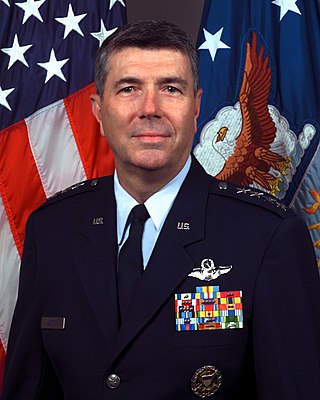
General Paul V. Hester is a retired United States Air Force officer. He served as Commander, Pacific Air Forces, and Air Component Commander for the Commander, United States Pacific Command from July 2004 to November 2007. He had responsibility for Air Force activities spread over half the globe in a command that supports 55,500 Air Force personnel serving in Hawaii, Alaska, Guam, Japan and South Korea.
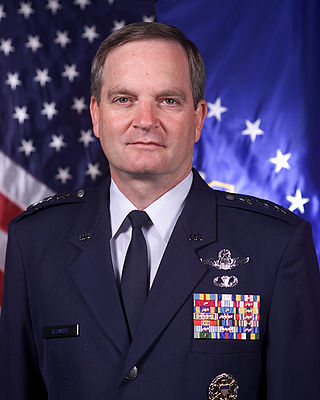
Randall Mark Schmidt was a lieutenant general in the United States Air Force.

Ralph Edward "Ed" Eberhart is a retired four-star general in the United States Air Force (USAF). He served as the commander of North American Aerospace Defense Command (NORAD) and United States Northern Command, Peterson Air Force Base, Colorado. He was in charge of NORAD during the September 11 attacks in 2001.
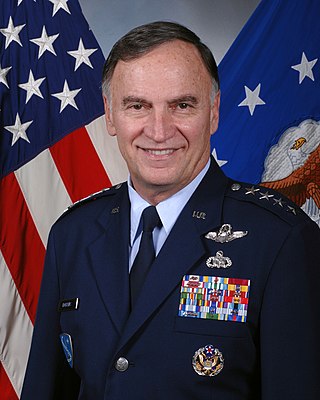
William Thomas Hobbins is a former Air Force general, commander of U.S. Air Forces Europe; commander of Air Component Command, Ramstein; and director of Joint Air Power Competence Center, Kalkar, Germany.
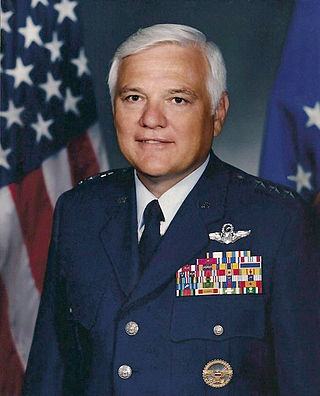
Lieutenant General Buster Cleveland Glosson was the deputy chief of staff for plans and operations at the headquarters of the United States Air Force (USAF) in Washington D.C. He was responsible to the secretary of the Air Force and chief of staff for the planning, operations, requirements and force structure necessary to support military operations. As the USAF operations deputy to the Joint Chiefs of Staff, he determined operational requirements, concepts, doctrine, strategy, training and the assets necessary to support national security objectives and military strategy.
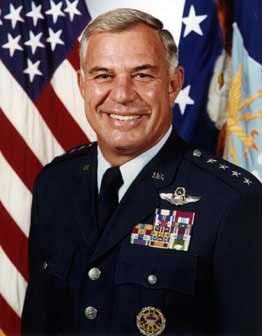
General John George Lorber was a retired four-star general in the United States Air Force (USAF). He served as commander of Pacific Air Forces, Hickam Air Force Base, Hawaii. As commander, he had responsibility for USAF activities spread over half the world in a command that supports 44,000 airmen serving principally in Hawaii, Alaska, Guam, Republic of Korea and Japan.

General Howell M. Estes III served as commander in chief in the North American Aerospace Defense Command (NORAD) and the United States Space Command (USSC), and served as commander in the Air Force Space Command (AFSC), headquartered at Peterson Air Force Base, Colorado. As commander, the general was responsible for the air sovereignty of the United States and Canada, providing tactical warning and attack assessment, directing space control and support operations, directing satellite control, warning, space launch and ballistic missile operations missions.

Burton M. Field is a retired United States Air Force lieutenant general. Prior to retirement he served as the deputy chief of staff for operations, plans and requirements, Headquarters United States Air Force.

Carrol Howard "Howie" Chandler, is a retired United States Air Force four-star general. He last served as the 35th Vice Chief of Staff of the Air Force from August 27, 2009, to January 14, 2011. He previously served as commander of Pacific Air Forces from November 2007 to August 20, 2009, and deputy chief of staff for operations, plans and requirements from October 23, 2005, to November 29, 2007. As vice chief, he presided over the Air Staff and served as a member of the Joint Chiefs of Staff Requirements Oversight Council and Deputy Advisory Working Group. He assisted the chief of staff with organizing, training, and equipping of 680,000 active-duty, Guard, Reserve and civilian forces serving in the United States and overseas. He retired from the Air Force by March 1, 2011. In 2012 he joined Pratt & Whitney Military Engines as vice president for military business development and international programs.
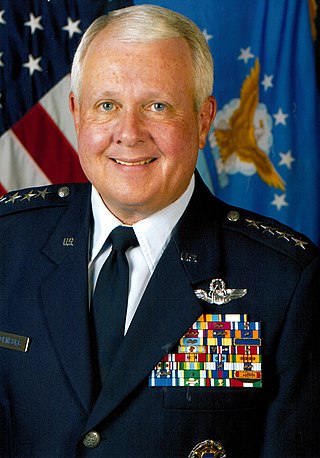
General Hal M. Hornburg was a four star U.S. Air Force general and commander, Air Combat Command, with headquarters at Langley Air Force Base, Virginia, and Air Component Commander for U.S. Joint Forces Command and U.S. Northern Command.

Gary Lewis North is a retired United States Air Force four-star general who served as commander of Pacific Air Forces and executive director of Pacific Air Combat Operations Staff at Hickam Air Force Base, Hawaii, from August 19, 2009, to August 9, 2012. Pacific Air Forces is responsible for Air Force activities spread over half the globe in a command that supports 45,000 airmen serving principally in Hawaii, Alaska, Guam, Korea and Japan.

Richard C. Johnston is a retired major general in the United States Air Force.

Lieutenant General Clyde Dewey Moore II is a retired United States Air Force officer who served as Commander, Air Force Life Cycle Management Center, Wright-Patterson Air Force Base, Ohio. The organization is the single center responsible for total life cycle management covering all aircraft, engines, munitions, and electronic systems.

Charles Quinton Brown Jr. is a United States Air Force general who has served as the 21st chairman of the Joint Chiefs of Staff since October 1, 2023. Prior to his appointment, Brown served as the 22nd chief of staff of the Air Force from 2020 to 2023. Brown entered the Air Force in 1984 and served as a fighter pilot, where he has logged over 3,000 flight hours, including 130 hours in combat. He has commanded the Pacific Air Forces, U.S. Air Forces Central Command, 31st Fighter Wing, 8th Fighter Wing, U.S. Air Force Weapons School, and 78th Fighter Squadron. He has also served as deputy commander of the U.S. Central Command.

Craven C. Rogers Jr. was a lieutenant general in the United States Air Force who served as deputy commander in chief of the U.S. Central Command at MacDill Air Force Base, Florida. The command was tasked with achieving United States national objectives in Southwest Asia, the Persian Gulf, and the Horn of Africa. Rogers was born in 1934, in Galveston, Texas. He earned a Bachelor of Science degree in engineering from the U.S. Military Academy in 1957 and a master's degree in business administration from The George Washington University. He completed Squadron Officer School in 1962 and the Industrial College of the Armed Forces in 1973. Upon graduation from the academy he was commissioned as a second lieutenant in the Air Force. After completing pilot training in September 1958 he was assigned to Tactical Air Command at Williams Air Force Base, Ariz., for gunnery training in the F-86F. With the phaseout of the F-86F, Rogers transferred in June 1959 as an instructor pilot to Air Training Command, Vance Air Force Base, Oklahoma. He completed F-101A transition training in September 1964 and then was assigned as a tactical fighter pilot with the 91st Tactical Fighter Squadron, Royal Air Force Station Bentwaters, England. In 1965 his squadron became the first unit in the United States Air Forces in Europe to transition to the F-4. Rogers assumed duties in the Standardization and Evaluation Section of the 81st Tactical Fighter Wing at Bentwaters in November 1966. In September 1967 he transferred to Nellis Air Force Base, Nevada, where he completed the F-4 Fighter Weapons School. In January 1968 he was assigned to the 557th Tactical Fighter Squadron, 12th Tactical Fighter Wing, Cam Ranh Bay Air Base, South Vietnam, as a flight commander and squadron weapons officer. He subsequently served as the wing weapons officer and assistant chief of weapons and tactics for 12th Tactical Fighter Wing. He flew 255 combat missions and 435 combat flying hours in the F-4C. He returned from Southeast Asia in February 1969 and was assigned to the Fighter and Reconnaissance Manning Section, Air Force Military Personnel Center, Randolph Air Force Base, Texas. He became chief of the section in 1971. Upon graduation from the Industrial College of the Armed Forces in August 1973, Rogers became deputy commander for operations, 1st Tactical Fighter Wing, MacDill Air Force Base, Florida. In June 1975 he transferred to Headquarters United States Air Force, Washington, D.C., as chief, Tactical Division, Directorate of Operational Requirements, Office of the Deputy Chief of Staff, Research and Development. In July 1977 Rogers was assigned as vice commander of the 4th Tactical Fighter Wing, Seymour Johnson Air Force Base, North Carolina. In June 1978 he became commander of the wing. He returned to Air Force headquarters in July 1980 and served as military assistant to the secretary of the Air Force. From June 1983 to July 1985 he was commander of United States Air Forces Korea; commander, United Nations Command Air Component; and commander, 314th Air Division, with headquarters at Osan Air Base, South Korea. He also was commander of the Korean Air Defense Sector, director of readiness and combat operations, and chief of staff of the Air Component Command/Combined Forces Command. Rogers then transferred to Hickam Air Force Base, Hawaii, as vice commander in chief, Pacific Air Forces. In December 1986 Rogers returned to Osan Air Base as commander, 7th Air Force; deputy commanding general, U.S. Forces Korea (Seoul); and deputy commander in chief, United Nations Command (Seoul). He is a command pilot with 5,200 flying hours. His military awards and decorations include the Defense Distinguished Service Medal with oak leaf cluster, Distinguished Service Medal, Legion of Merit with two oak leaf clusters, Distinguished Flying Cross with oak leaf cluster, Bronze Star Medal, Meritorious Service Medal with oak leaf cluster, Air Medal with 13 oak leaf clusters, Air Force Commendation Medal, Korean Order of National Security Merit (Chunsu) and Korean Order of National Security Merit (Kuksun). He was promoted to lieutenant general January 1, 1987, with same date of rank. He retired on April 1, 1991, and died on August 4, 2016.

John A. Bradley was a lieutenant general in the United States Air Force who served as Commander of the United States Air Force Reserve Command, Headquarters U.S. Air Force, Washington D.C., and commander, Headquarters Air Force Reserve, a separate operating agency located at Robins Air Force Base, Georgia. As chief of Air Force Reserve, he served as the principal adviser on Reserve matters to the Air Force Chief of Staff. As commander of AFRES, he had full responsibility for the supervision of U.S. Air Force Reserve units around the world.

James Michael Holmes is a retired United States Air Force general. He was the Deputy Chief of Staff for Strategic Plans and Requirements at Headquarters United States Air Force in Washington, D.C., before he became the commander of Air Combat Command on March 10, 2017. He was succeeded by Mark D. Kelly and retired effective 1 October 2020.
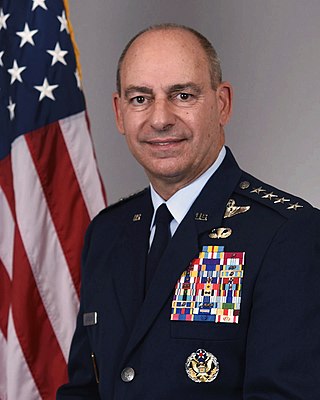
Jeffrey Lee Harrigian is a retired United States Air Force general who last served as the commander of United States Air Forces in Europe and Air Forces Africa from May 2020 to June 2022. He concurrently served as the commander of Allied Air Command and director of the Joint Air Power Competence Center. He previously served as deputy commander and as commander of United States Air Forces Central Command. Raised in Sparks, Nevada, he graduated from the United States Air Force Academy with a degree in International Affairs and was commissioned in 1985. He assumed his capstone assignment on May 1, 2019.

Joseph Thomas Guastella Jr. is a retired lieutenant general in the United States Air Force who served as the Deputy Chief of Staff for Operations of the United States Air Force. He was commissioned upon his graduation from the United States Air Force Academy in 1987.



















